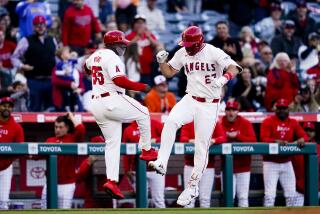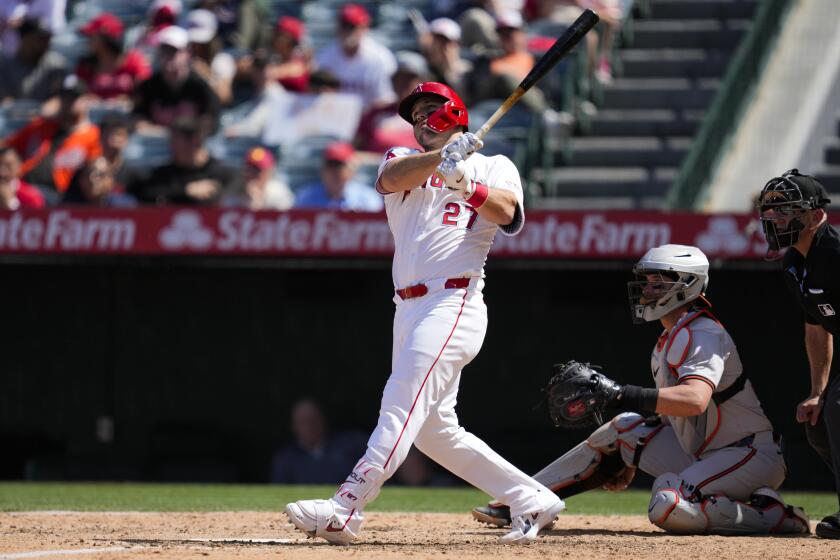Moreno’s Latest Is Sheer Bluff
Hardballs from the mothballs of semiretirement ...
Arte Moreno seized the moment again with his decisive signings of Steve Finley and Orlando Cabrera, but it was beneath the Angel owner to suggest that he might eventually pack up his bats and balls and move the team if legal obstacles prevent him from implementing the ridiculous name change.
Legitimate leverage is one thing, but where exactly would the Angels go? Las Vegas? New Jersey? Wasn’t it only yesterday that Major League Baseball conducted a prolonged and failed search for a viable home for the Montreal Expos before swallowing internal concerns and returning to Washington for a third try?
Moreno also showed poor taste in suggesting that he was being forced to play in an old facility. The Anaheim foundation may have been laid in the mid-’60s, but the renovation of the late ‘90s -- paid for by the city and Walt Disney Co. and from which Moreno benefits -- left a ballpark that compares favorably to any of baseball’s newer ones. Besides, that old facility hasn’t stopped Moreno from charging modern ticket prices.
*
The sweep of Jose Canseco’s accusations is so broad, and the depth of his credibility so shallow, that it is impossible to know where the reality starts and ends in his much-chronicled book.
Make no mistake, however. It’s a payday for Canseco and a personal payback at a business that ultimately blackballed him and, in particular, at Mark McGwire for achieving a level of success Canseco once envisioned for himself, but the book -- jaundiced as it is -- can be viewed as the ultimate white paper on an era rife with steroid use and blind neglect by union and management.
The new drug policy will force some of the cheats to go straight, but it falls short, failing to provide for the blood tests necessary to identify human growth hormone or outlawing any of the amphetamines that have been almost as available as bubblegum in big league clubhouses for more than 40 years.
Of course, whether any policy can keep pace with the production of new and undetectable designer steroids is another issue. More than BALCO is at work out there, more shoes and shooters will drop, and Canseco will have the chance to do Volume II, God help us.
*
So, Mike Greenwell, runner-up to Canseco in voting for the American League’s most-valuable-player award in 1988, is saying that Canseco should be stripped of the award because of his admitted steroid use and that it should be shipped to Greenwell.
This presumes that Canseco is no longer under house arrest and can get to UPS. It also presumes that we can quantify the extent to which steroids benefit a hitter or pitcher. Since we can’t, and since steroids weren’t illegal in baseball during that era of bigger biceps and bombs, the statistics and records will have to be what they are, the situation what it is.
Writers are free, of course, to apply as much taint as they want, to cast their Hall of Fame votes for whomever they want. Fans can yell whenever they want at whomever they want. There is no basis, however, for expunging an era or cluttering the Baseball Encyclopedia with footnotes. Nor is there any reason to believe the media’s steroid hysteria has turned off fans, if they even care.
Major league attendance topped 73 million last season, a record. The total this year is expected to surpass that.
*
From his small-market bunker, amid the feeding frenzy of the off-season, Pittsburgh Pirate owner Kevin McClatchy concluded that many of his colleagues must have drunk “some funny water.”
Indeed. Inspired by the widening parity, attendance growth and a built-in escalation in revenue sharing, owners fell hard off what had been their more cautionary wagon of the previous two off-seasons when agents were whispering the “C” word -- collusion.
The fall was so sudden, so precipitous, that owners were again heard to mumble that the system had to change.
Translation: They need help controlling themselves.
With spring camps open and the accountants having totaled the damage, it can be reported that teams committed more than $1.3 billion to player contracts, with 106 players signing for at least $1 million apiece and 11 signing for at least $10 million a year.
Six of the 11 signed multiyear contracts for $50 million or more, and the Seattle Mariners (Adrian Beltre and Richie Sexson) and New York Mets (Pedro Martinez and Carlos Beltran) signed four of the six.
From the Mets’ three-year, $22.5-million kickoff signing of Kris Benson (47-53 record) to the Detroit Tigers’ five-year, $75-million wrap-up signing of Magglio Ordonez (coming off two knee surgeries), it was as if the owners were insistent on playing a comedy game of “Can You Top This?”
No signing was any more grievous than any other -- well, Benson and Ordonez are hard to top, and it’s hard to believe that David Eckstein went from an Angel non-offer to a three-year, $10-million contract with the St. Louis Cardinals -- but grievousness definitely touched down in Los Angeles as well.
It’s impossible to understand how the Dodgers allowed Beltre to leave after a breakthrough year, then signed oft-injured J.D. Drew to a five-year, $55-million contract. Drew has never driven in 100 runs in a season, never made an All-Star team and has had 450 or more at-bats in a season only once.
The most curious and numbing aspect of his contract is that he can leave after two years if he believes he can find greater reward in the market, but the Dodgers are saddled with all five years if he is injured or unproductive.
Then again, with all of that renovation at Dodger Stadium, maybe it’s natural that some funny water would be coming out of the pipes.
More to Read
Go beyond the scoreboard
Get the latest on L.A.'s teams in the daily Sports Report newsletter.
You may occasionally receive promotional content from the Los Angeles Times.






